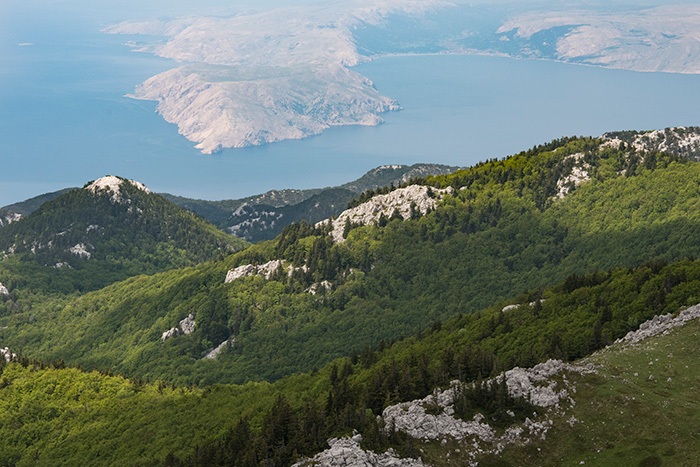
Croatia, every year a destination of many tourists, it is able to enchant us with its nature and beauty.
Crossed by mountains and touched by Adriatic sea, Croatia has an extraordinary wealth of landscapes, fauna and flora. If you are in love with long hikes surrounded by nature, Croatia is perfect for you.
There are many national parks, very well managed, like the famous “Plitvice Lakes National Park”.
Here, we have the chance to see waterfalls, lakes and small stream, walking on wooden walkways, bridge, and cross lakes with small ferries.
In addition to the most famous path of the park, there are others that across beautiful beech forests, where we can see the bosnian lily (Lilium bosniacum) and various orchids, like the fly orchid (Ophrys insectifera) or the rare lady’s-slipper orchid (Cypripedium calceolus).
If you are very lucky you can see otters (Lutra lutra) and the ural owl (Strix uralensis).
Going to the coast we meet a long mountain range, the Velebit, belonging to the Dinaric Alps.
In the northern and in the southern part there are two big national parks, respectively the Northern Velebit National Park and the Paklenica National park, the latter is characterized by two canyon, the bigger and more touristic is the Velika Paklenica, the smaller is Mala Paklenica.
If you are climbers, these two canyon are the best, because there are more of 400 climbing routes, from the simplest to the most difficult and there is the chance to rent the equipment at the park entrance.
The Paklenica National Park is not only climbing, it is mostly wilderness, here we have the possibility to see the chamois (Rupicapra rupicapra), very abundant in this area, and if we have a lot of luck, maybe we can see the brown bear (Ursus arctos), that lives throughout the mountain range. Every year some very lucky hikers see it, right place, right time.
If we decide to visit Velika Paklenica there is a very well managed and easy path that leads us to two alpine huts, the first is only a two hour walk, the second is a two and a half hour walk from the car park.
For the adventurous people, there are many others paths that start from the main path, less touristy, but very emotional, for example you can reach the highest peak, the Vaganski vrh (1758 m).
Along the ways there are information panels that explain the peculiarities of the place and the maps indicate which paths are best avoided due to the difficulty or for the possible presence of anti-personnel mines.
The Northern Velebit National Park is very beautiful too, full of paths, from the easier to the harder, some of them show us breathtaking views, like the short path which goes up to the Balinovak, from the car park at Zavizan. Here, with only 30 minutes of walk, we can see some of the Adriatic Sea islands, like Krk and many others.
But the rare pearl of the paths is the Premuzic, in croatian Premuziceva staza, the design and construction started in the 1930 by a forest engineer, mountaineer and lover of croatian mountains, and ended in 1933.
The peculiarity of this path is that it’s built with stones, and in some spots it is supported by dry stone walls, making it very impressive. It is almost 60 km long, reaching to the Middle Velebit, but only 16 km are inside the national park. The most interesting part is the Rosansky kukovi, at 2 hours of walk from the car park, here we can see the beautiful of the karst landscape, the engineering work of the water on the rocks.
For the lovers of caving, here there is one of the deepest pits in the world, the Lukina jama, with 1400 m of depth. As in the whole mountain range, we have the possibility to see the western capercaillie (Tetrao urogallus), or maybe we can see some trace of presence of the three great european predators, the brown bear (U. arctos), the wolf (Canis lupus) and the very shy european lynx (Lynx lynx)
For those that loves the maritime area, Croatia is full of islands, over 500, most of them are accessible by ferry, the others, like Krk, the biggest island of Adriatic Sea, by bridge.
I am an herpetologist and when I visited the island of Krk, I searched for reptiles, and here as in all Croatia, especially islands, they are very abundant.
I had the chance to find the famous Pallas's glass lizard (Pseudopus apodus), that although it looks like a snake, it is actually a legless lizard, like the slowworm, but much bigger, and the beautiful blue-throated keeled lizard (Algyroides nigropunctatus), a small lizard with very colorful males, especially in the breeding season, indeed they have a blue head and a red body.
For spider lovers in some spot of the island it is possible to see the true “tarantula” (Lycosa tarantula), a big wolf spider, harmless to humans, that dig burrows in the ground where they lives during the day, as they go out hunting at night.
And if you have the chance to hike on the highlands that surround Baska, you can observe some griffon vultures (Gyps fulvus), a vulture with 280 cm of wingspan, that nests on the cliffs overlooking the sea.
So, whether you are a botanist, an ornithologist or a simply nature lover, Croatia will surely satisfy you.

